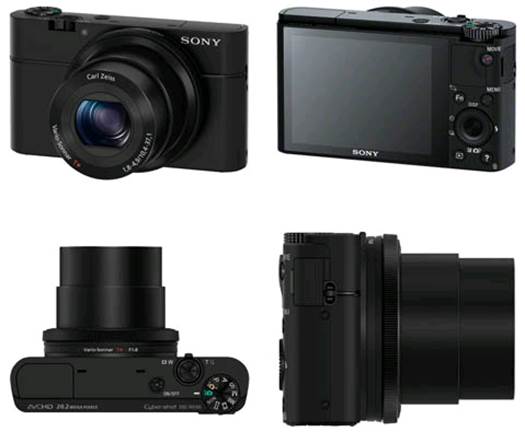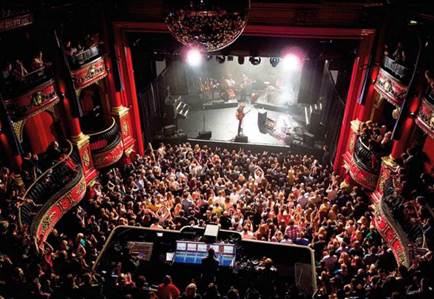This powerful but easy to use compact
camera is perfect for shooting bands and live performances, as leading music
photographer Richard Johnson reveals.
Live performances make for thriving
photography, but it's not for the faint-hearted. The combination of constantly
moving performers and unpredictable lighting can really test a camera, so you
need to be able to rely on your gear 100%. For this reason, well respected
music photographer Richard Johnson swears by his Sony RX100.
"The size and weight of the RX100 make
it ideal for taking photographs at gigs, while the unfussy interface and
logical layout help you react quickly when you need to essential when shooting
bands! The quick shutter release is also great for capturing energetic moments
instantly."

Sony
RX100 - Music to your ears!
Another big challenge when shooting live
bands is coping with low light, so the RXIOO's versatile light sensitivity
(ISO) is a real help to Richard. "The fact that you can shoot at ISO 6400
with the RX100, and open the aperture as wide as f/1.8, makes shooting gigs so
much easier."
Of course, a camera is only as good as its
resolution and optics, and Richard again reckons the RX100 scores highly here.
"I really believe that the RX100 is a genuine contender against many SLRs
for my kind of work. Indeed, its large sensor, compact size and quality lens
means I can happily use this in addition to my heavy pro SLRs."
How to shoot bands
Richard has some great tips to get better
shots of live performances. "First, select a high ISO (800-3200) and use a
wide aperture to cope with low-light situations. I set the lens ring to
aperture mode so I can anticipate lighting changes quickly. If the venue allows
it, you can also use the RXIOO's pop-up fill flash to freeze movement when
people go wild to the music. Then, be sure to choose your focus area with the
Flexible Spot mode, especially when shooting with a wide aperture. This will
help to get your pictures pin sharp with a low depth of field - nicely blurring
the focus, in other words. Finally, use the RXIOO's Function button to
customise the modes you change the most. This enables you to quickly access the
settings you use most often, such as ISO, focus setting, image quality and so
on."
As mentioned, shooting live bands is
difficult because you're often relying on unpredictable stage lighting in dark
conditions. Here's Richard's advice: "To get band members sharp, I select
my exposure manually and choose my focus points so I can fire away. This gives
nice sharp, atmospheric shots that portray the gig as everybody sees it.
Flexible Spot focus mode is great for selecting exactly which area of the image
I want to be sharp."
Another great tip is to use flash with a
bit of blur. As Richard explains, you do this by using the RXIOO's Slow Sync
flash mode. "It means I can light the subject with flash and expose for
the background. This comes in very useful when the guitarist or singer is jumping
all over the place!"
Another must for quality photos of live
performances is shooting in raw, rather than the JPEG format, something that's
easy with the RX100. "The raw file format will give you the highest
quality image and will contain the most data, giving you more leeway to edit
the image in editing software like Photoshop or Lightroom."

Joshua
Radin performs at KOKO London.

The
RX100’s powerful ExmorTM CMOS sensor picks up loads of detail and
colour, even when I’m using a high ISO.

Scars
on 45 at KOKO London, also shot on the RX100.

I
took this shot at f/1.8, using the Flexible Spot focus to get the singer
absolutely pin sharp - even with a really low depth of field.

The
wide-angle lens and flexible focus point allowed me to capture all the atmosphere
at the gig, just as the light was right.
|
Here's a more detailed guide to Richard's weapon of choice
·
Sensor: 20.2-megapixel
CMOS
·
Max resolution: 5472 x
3648
·
ISO range: Auto,
100,200,400, 800,1600,3200,6400, 12800, 25600
·
Focal length: 28-100mm
·
Optical zoom: 3.6x
·
Autofocus option: Contrast
Detect (sensor), Multi-area, Center, Selective single-point, Tracking,
Single, Continuous, Face Detection
·
Manual focus: Yes
·
Max aperture: f/1.8-f/4.9
·
Shutter speed: 1/2000-30
sec
·
Built-in flash: Yes
·
Flash modes: Auto, On,
Off, Slow Sync
·
Continuous drive: Up
to 10fps
·
Metering modes: Multi,
Center-weighted, Spot
·
Exposure compensation: +/- 3EV (at 1/3EV steps)
·
HD video: Yes (1080p)
·
Weight: 240g
·
Dimensions: 102x59x36mm
|